Molar mass 144.11 g/mol Density 1.5 g/cm³ | Melting point 410 °C | |
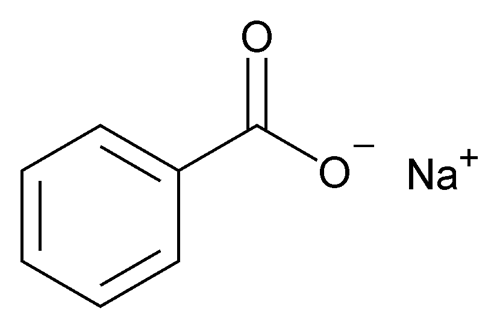 | ||
Appearance white or colorless crystalline powder | ||
Sodium benzoate is a substance which has the chemical formula NaC7H5O2. It is a widely used food preservative, with an E number of E211. It is the sodium salt of benzoic acid and exists in this form when dissolved in water. It can be produced by reacting sodium hydroxide with benzoic acid.
Contents
- Preservative e211 sodium benzoate
- Preservative
- Pharmaceutical applications
- Other uses
- Mechanism of food preservation
- Production
- Health and safety
- Association with benzene in soft drinks
- Hyperactivity
- Compendial status
- References

Preservative e211 sodium benzoate
Preservative
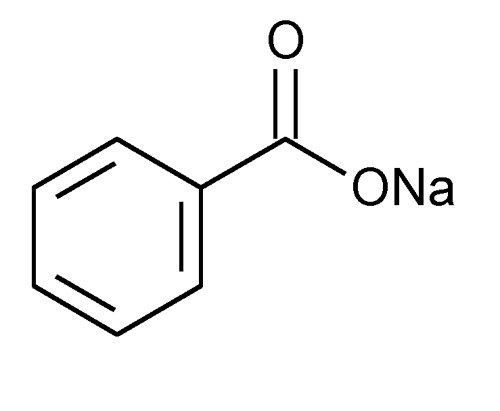
Sodium benzoate is a preservative. As a food additive, sodium benzoate has the E number E211. It is bacteriostatic and fungistatic under acidic conditions. It is most widely used in acidic foods such as salad dressings (vinegar), carbonated drinks (carbonic acid), jams and fruit juices (citric acid), pickles (vinegar), and condiments. It is also used as a preservative in medicines and cosmetics. Concentration as a food preservative is limited by the FDA in the U.S. to 0.1% by weight. Sodium benzoate is also allowed as an animal food additive at up to 0.1%, according to AFCO's official publication.
Pharmaceutical applications

Sodium benzoate is used as a treatment for urea cycle disorders due to its ability to bind amino acids. This leads to excretion of these amino acids and a decrease in ammonia levels. Recent research shows that sodium benzoate may be beneficial as an add-on therapy (1 gram/day) in schizophrenia. Total Positive and Negative Syndrome Scale scores dropped by 21% compared to placebo.
Sodium benzoate is used to treat hyperammonemia.
Sodium benzoate has been shown to halt the progression of Parkinson's in mice.
Other uses
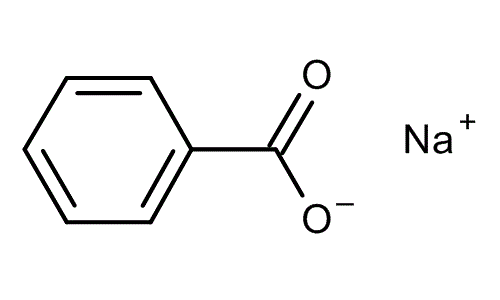
Sodium benzoate is also used in fireworks as a fuel in whistle mix, a powder that emits a whistling noise when compressed into a tube and ignited.
Mechanism of food preservation
The mechanism starts with the absorption of benzoic acid into the cell. If the intracellular pH falls to 5 or lower, the anaerobic fermentation of glucose through phosphofructokinase decreases sharply, which inhibits the growth and survival of microorganisms that cause food spoilage.
Production
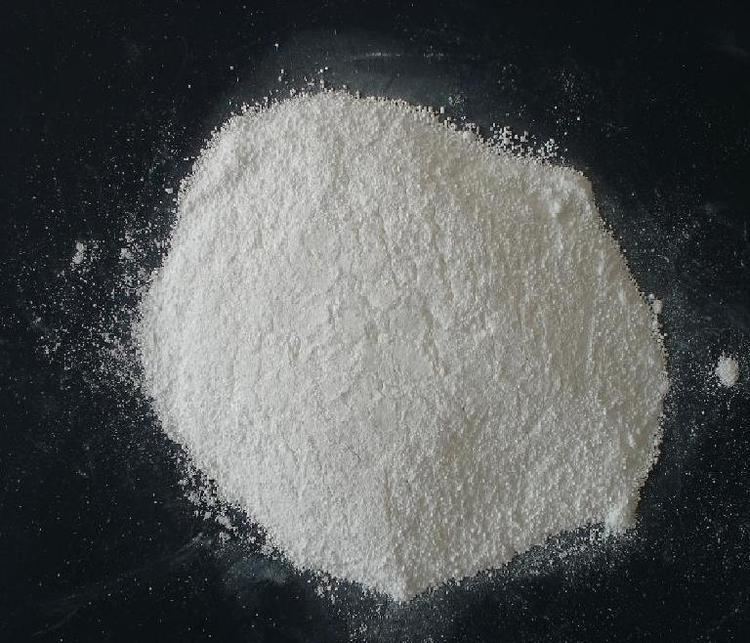
Sodium benzoate is produced by the neutralization of benzoic acid with sodium hydroxide. Sodium benzoate can also be prepared by adding benzoic acid to a hot concentrated solution of sodium carbonate until effervescence ceases. The solution is then evaporated, cooled and allowed to crystallize or evaporate to dryness, and then granulated.
Health and safety

In the United States, sodium benzoate is designated as generally recognized as safe (GRAS) by the Food and Drug Administration. The International Programme on Chemical Safety found no adverse effects in humans at doses of 647–825 mg/kg of body weight per day.
Cats have a significantly lower tolerance against benzoic acid and its salts than rats and mice.
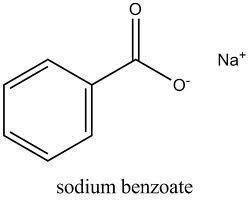
A paper published in the March 2015 Journal of the Science of Food and Agriculture found that sodium benzoate has been replaced by potassium sorbate in the majority of soft drinks in the United Kingdom to avoid the use of anything the consumer might consider an additive, particularly in connection with colours and preservatives.
Association with benzene in soft drinks

In combination with ascorbic acid (vitamin C, E300), sodium benzoate and potassium benzoate may form benzene, a known carcinogen. When tested by the FDA, most beverages that contained both ascorbic acid and benzoate had benzene levels that were below those considered dangerous for consumption by the World Health Organization (5 ppb). Most of the beverages that tested higher have been reformulated and subsequently tested below the safety limit. Heat, light and shelf life can increase the rate at which benzene is formed.
Hyperactivity
Research published in 2007 for the UK's Food Standards Agency (FSA) suggests that certain artificial colors, when paired with sodium benzoate, may be linked to hyperactive behavior. The results were inconsistent regarding sodium benzoate, so the FSA recommended further study. The Food Standards Agency concluded that the observed increases in hyperactive behavior, if real, were more likely to be linked to the artificial colors than to sodium benzoate. The report's author, Jim Stevenson from Southampton University, said: "The results suggest that consumption of certain mixtures of artificial food colours and sodium benzoate preservative are associated with increases in hyperactive behaviour in children. . . . Many other influences are at work but this at least is one a child can avoid."
Sodium benzoate may trigger or exacerbate symptoms or episodes of attention-deficit/hyperactivity disorder, or ADHD, according to the Mayo Clinic. The condition is most common in children but it can be present in adults as well, and affected individuals may be forgetful, have difficulty concentrating and following directions or display impulsiveness.
In response to consumer insistence on a more natural product, the Coca Cola Company is in the process of phasing sodium benzoate out of Diet Coke. The company has stated it plans to remove sodium benzoate from its other products — including Sprite, Fanta, and Oasis — as soon as a satisfactory alternative is discovered.
